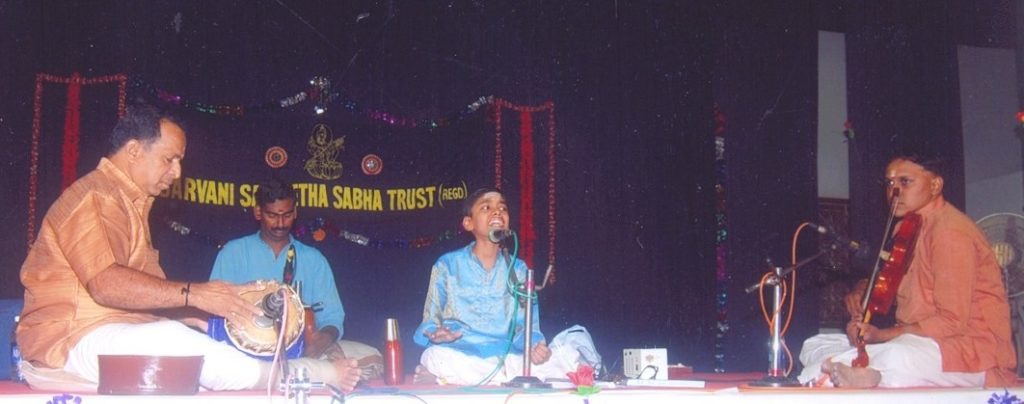Young achiever
Master S. Mahadevan , the teenager from Thiruvananthapuram, is conversant in playing the veena and the violin, besides being a singer. He is a student of Parasala Ponnammal.
Mahadevan focussed on Maharaja Swati Tirunal’s kritis. His selection – ‘Jagadeesa Sada Mamava’ in Natakurunji, ‘Paripahi Madhava’ in Mohanam (with niraval and swaras) and the main piece ‘Paripalaya Sarseeruha’ in Pantuvarali — illustrated the youngster’s ability to present ragas and swaras in the right perspective.
Mahadevan’s composure was another favourable point. He showed signs of becoming a vocalist with a strong sense of melody. His performance was encouraged by Thiruvananthapuram N. Sampath on the violin, Udipi Sridhar on the mridangam and Thiruvananthapuram R. Rajesh on the ghatam.
BRVS Pavan Kumar Charan of Vizianagaram presented a vocal concert based on the works of these composers. Pavan Kumar’s robust voice which can traverse the three octaves effortlessly is his strength.
He began with Toomu Narasimhadas’s ‘Meluko Sugunavala’ in Bowli. The repertoire included ‘Gayathi Vanamali’ (Hamsadhwani), ‘Pibare Ramarasam’ (Chakravaham), ‘Nihare Nahin’ in Valaji and ‘Ikshvaku Kula Thilaka’ in Yadukulakhambodi. The main item was ‘Ennaganu Rama Bhajana’ in Pantuvarali by Bhadrachala Ramadas.
Most of the kritis of these composers are often used as tail-end pieces. Pavan Kumar’s rendition cannot be flawed. However, he could not elevate the concert to the level to a traditional one as his presentation was sans alapana or swaras. Even the singular elaboration of Pantuvarali moved on an easy peripheral approach and vocal demonstration. Similarly, the niraval and swaras followed on ‘Ramachiluka’ sounded more like a medley and ended with an abrupt korvai. With a powerful voice like his, Pavan Kumar needs to put in more effort to express his manodharma.
The accompanists always take the cue from the vocalist. B.Ananthakrishnan (violin) and Guru Raghavendra (mridangam) followed the frothy touch of the main artist.
Bhava-laden
“Since the concert is meant to highlight the importance of the compositions, I will keep my raga essays and swaras precise,” said Vani Sateesh before her recital on Purandara Dasa kritis. A laudable view, indeed! However, Vani did not give the raga essays or swaras just a go by. Her articulation of Sankarabharanam and Purvikalyani testified her musical wisdom. Another commendable aspect was that she not only gave a brief introduction about Purandara Dasa, but also explained the profound meaning of the kritis she had chosen. ‘Sripathiyu Namage’ in Sri, ‘Rama Mantrava Jabiso’ in Kanada, ‘Rama Rama Yenilo’ in Vasantha and the central ‘Manava Janma Doddadu’ in Purvikalyani were good selections.
Vani’s vocal chords are powerful and her presentation was brimming with confidence. Anayampatti G. Venkatasubramaniam on the violin, B. Ganapathyraman on the mridangam and G. Chandrashekara Sarma on the ghatam proved good accompanists throughout.
If one closes one’s eyes and listens to the music, one would believe the voice belongs to a of a well trained singer.
